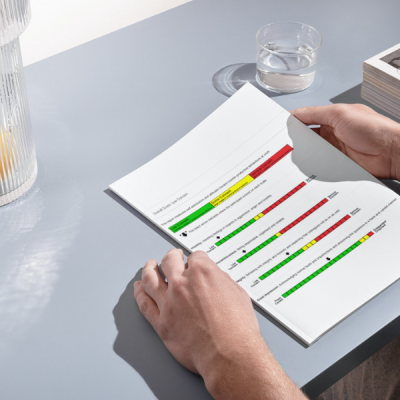Understanding the Big5 Model of Psychometric Profiling
14 Nov 2022The Care Advantage Personality Assessment is based on the Big5 Model of psychometric profiling. The Big5 model – also known as the Five Factor Model (FFM) is a widely accepted framework that describes five broad dimensions of personality considered the most stable and accurate.
What are the 5 Dimensions of Personality?
The five dimensions in the Big5 Model are openness, conscientiousness, extraversion, agreeableness, and neuroticism, which is easily remembered by the acronym OCEAN. The Care Advantage Personality Assessment is based on the Big5 model, however has renamed the core traits and added an additional trait: the Teamscale. These are the Care Advantage traits:
Conscientious (conscientiousness): Describes the degree to which the individual is persistent, organised and motivated. At the high end, people are careful, organised, meticulous, precise, orderly, punctual, and comfortable with details. On the low end, this scale identifies people who tend to be unsystematic, spontaneous, prefer little or no planning, have a relaxed view of time, and are typically more
comfortable dealing with interruptions.
Tough-Minded (agreeableness): Describes the degree to which the person is pleasant and agreeable. At the high end, such people are tough-minded, assertive, outspoken, and happy to deal with difficult interpersonal situations. On the low end people are warm, pleasant, agreeable people who relate easily to and generally get along well with others.
Conventional (openness): Involves the degree to which the person is open to new ideas, is adventurous. At the high end, these people tend to be predictable and observe and comply with rules, regulations, and established policies and procedures. On the low end, such persons seem free-wheeling and non-conforming, preferring to work with few guidelines while preferring change and minimal structure.
Extroversion (extraversion): Describes the sources and focus of an individual’s emotional energy. At the high end, such people are gregarious, outgoing, and engaging, and have a propensity toward risk-taking, a desire to talk rather than listen, and a preference for engaging in interactions with others rather than being alone. At the low end are persons who are reserved, tend to avoid risks, and prefer to be and work alone, they tend not to engage others emotionally, although they do tend to be better listeners.
Stable (neuroticism): Involves the degree to which an individual is emotionally stable and resistant to stress. At the high end, this trait identifies persons who are resilient, handle stress well, have stable moods, are relatively free from worry, anxieties or apprehension, and have a generally positive outlook on life. At the low end are people who are apprehensive, readily express worries and anxieties, and generally have a higher level of sensitivity to others as well as their environment.
Team: measures the participant’s preference for working by themselves or as part of a team.
Good Impression: inquires about behaviours “too good to be true,” and, like all such measures typically included in high-quality personality tests, is a measure of the tendency to present oneself in an unrealistically favourable light.
Why is the Big5 Model Important?
The Big5 model is important because it provides a comprehensive and widely accepted framework for understanding and assessing personality. It has been extensively researched and validated, and is used in many organisations to identify the best candidates for a job. By using the Big5 model, organisations can gain a deeper understanding of a candidate’s personality, which can help to predict their behaviour, motivations, and job performance.
How is the Big5 Model Measured?
The Big5 model is typically measured using a self-report questionnaire or an assessment that asks the candidate to rate themselves on a range of personality traits. The results of these assessments are then analysed and interpreted to determine the candidate’s scores on each of the five dimensions of personality. These scores can then be used to develop a comprehensive profile of the candidate’s personality, which can help organizations to make informed decisions about their suitability for a particular job. The Care Advantage Personality Assessment uses 45 questions to measure the applicant on the 5 Big5 traits, but also the additional Team Focus trait as well as their level of “impression management“.
How is the Care Advantage Personality Assessment used?
Once a participant has completed the Care Advantage Personality Assessment, a wide variety of reports are readily available for pre-employment screening, development and vocational purposes. For example, the Personality/Job Fit report gives insight into the participant’s personality profile and compares that profile to a benchmark job profile to quickly gauge the match and possible gaps. The On-boarding report is a summary of the person’s personality profile including tips and can be given to the direct manager for more insight into workstyle. Several Leadership reports can be used for development into leadership roles and lastly, the Career Trait Profile can be given to participants to give them insight into their personality profile in relation to 6 universal career traits.
Care Advantage can help organisations get insight into personality traits, characteristics and values of their job applicants. Invaluable information for hiring decisions. By using behavioural assessments, you’re setting an identical standard and a structured approach to gathering information about your potential hires, compared against a benchmark of high performers in the same job type. The assessment results can help organisations, screen in hidden talent and screen out potential hiring risks. Care Advantage benchmarks are developed by occupational psychologists, set for Australian and New Zealand norms, specifically for the health care and social assistance sectors.
If you’re interested in exploring the world of behavioural assessments and would like to know more about Care Advantage, get in touch with us at info@careadvantage.com.au.
[1] https://www.roberthalf.com.au/press/rising-costs-bad-hire
[2] https://www.indeed.com/career-advice/resumes-cover-letters/what-happens-if-you-lie-on-your-resume
[3] https://www.seek.com.au/employer/hiring-advice/how-to-tell-when-a-candidate-is-lying
[4] https://www.pursue.ly/professional-references





